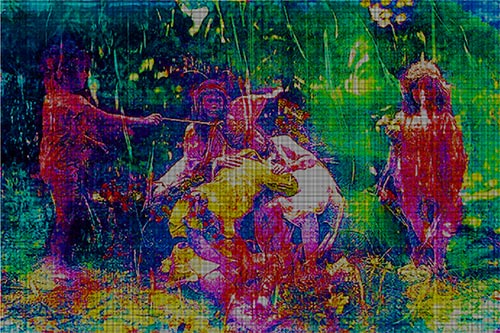In the Orbicularis Oris series of portraits, the mouths of late-night television hosts Jay Leno, David Letterman, and Conan O’Brien are swapped out with the mouth of Johnny Carson, signifying that oral gestures may be fungible, but speech is unique. The reduction of the images to black and white, fractionated, and overlaid with a dot grid, reflects the monologuist’s digital-like double entendre and is left to the discretion of the viewer to color. Thus, the bed-time talk show becomes the artistic medium for the viewers’ visual dreamscapes.

Shakespeare’s monologues are the oeuvre to character dialogues within later acts and scenes much like Carson’s and his successors’ are to interviews and performances within their telecasts. However, Shakespeare’s double entendre, called ‘doubling’, explores the vagaries of reality as in the daylight queen and king, Hippolyta and Theseus in Act 1 and the nighttime queen and king, Titania and Oberon in Act 2. Kolker’s Encaustic Gardens (1996), oil and encaustic on panel, depicts a scene from “A Midsummer Night’s Dream” staged in 1914 by children of a prominent American family in the garden of their estate, which is now Old Westbury Gardens. The painting was fractionated and overlaid with a dot grid (a process-driven style called fracolor) creating a series of paintings and prints comporting with the literary-style doubling; Dot Dream Lucida (2009) of a grayscale image fractionated with a white grid of dots, Dot Dream Invers (2009) of a negative image or black/white reversal fractionated with a grid of black dots; Dot Dream Fauve (2009) a supersized large scale image of unreal color corresponding to an ecstatic and chromatically explosive dreamscape, as picture above.
With his use of the dot grid reminiscent of our digital television and computer screens, Kolker illuminates the gaps between reality and dreams. From his curatorial juxtaposition of his works, drawn from contemporaneous late night television and Elizabethan theater, Kolker visually explores the realm of the comedic monologue and the real world filled with fantasy and dreams.
Paul Kolker: Shakespeare and A Midsummer Night’s Dream… Go Digital! The Monologue — July 16 through September 5, 2009.
